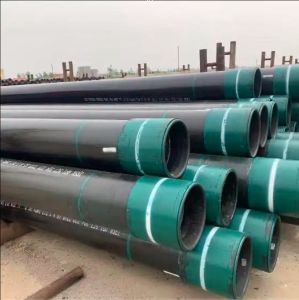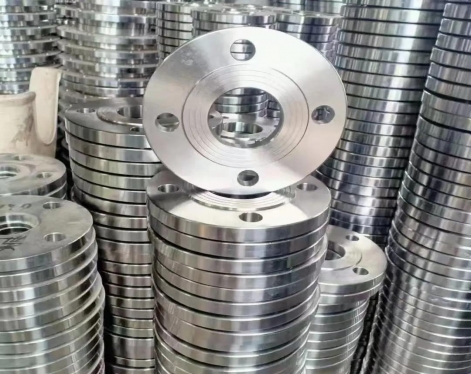OCTG stands for "Oil Country Tubular Goods," which refers to a category of specialized steel pipes used in the exploration, production, and transportation of oil and natural gas. These pipes are essential components in the oil and gas industry, serving various functions from drilling to well completion and production. OCTG pipes come in a range of sizes, grades, and specifications to meet the specific requirements of oil and gas operations. Let's delve deeper into the types, and applications of OCTG pipes.
1.Types of octg pipe
(1)OCTG casing pipe
Oil casing is a large-diameter pipe that plays a role in fixing the walls or wellbore of oil and natural gas wells. The casing is inserted into the wellbore and fixed with cement to help the wellbore separate the rock formations and prevent the wellbore from collapsing, while ensuring the circulation of drilling mud to facilitate drilling and mining.

①Type
Conduit, surface casing, technical casing and oil layer casing according to usage.
②Structure
The hose consists of an inner rubber layer, six layers of steel wire winding layers and an outer rubber layer.
③Usage
Suitable for transporting hydraulic fluid, hydraulic oil, fuel, lubricating oil, emulsion, ethylene glycol aqueous solution and water, etc.
④Working temperature: -40℃~ +120℃
⑤Pressure: 51-6s 105mpa 102-6s 70mpa
⑥Classification of casing end processing forms
Short round thread, long round thread, partial trapezoidal thread, special buckle, etc. It is used in oil well drilling mainly to support the well wall during the drilling process and after the well completion, so as to ensure the progress of the drilling process and the normal operation of the entire oil well after the well completion.
⑦Grades
According to the strength of the steel itself, casing can be divided into different steel grades, namely J55, K55, N80, L80, C90, T95, P110, Q125, V150, etc. Different well conditions and well depths require different steel grades. In corrosive environments, the casing itself is also required to have corrosion resistance. In places with complex geological conditions, the casing is also required to have anti-collapse properties.
2.Tubing Pipe
Tubing pipes are pipelines that transport crude oil and natural gas from oil and gas formations to the surface after drilling.The processing forms of oil pipe ends are: non-thickened with threads and couplings, externally thickened with threads and couplings, flat end, non-thickened with threads and couplings, externally thickened with threads and couplings.
②Structure
The high-pressure oil pipe is composed of a steel wire-wrapped skeleton layer and internal and external oil-resistant rubber, corrosion-resistant synthetic rubber, and weather-resistant special rubber.
③Usage
Used in excavators, loaders, rollover trucks, hydraulic boosters, hydraulic supports, cement delivery pipes, agricultural irrigation hoses, engineering machinery hydraulic oil pipes, submarine natural gas transmission, and oil transportation.
Tubing pipes are divided into flat oil pipes (NU), thickened oil pipes (EU) and integral joint oil pipes (IJ). Flat oil pipe means that the pipe end is directly threaded and coupled with a coupling without thickening. Thickened oil pipe means that after both ends are externally thickened, they are then threaded and coupled with couplings. Integral joint oil pipe means that one end passes through the internal thickening of the external thread, and the other end passes through the external thickening of the internal thread, and is directly connected without a coupling.
3.Drill Pipe
Drill pipe is used in the drilling process to transmit drilling fluid and rotational torque from the surface to the drill bit at the bottom of the wellbore. It is subject to high axial and torsional loads and must withstand bending, fatigue, and abrasion during drilling operations . Drill pipe is typically produced with integral or welded tool joints and is available in various lengths and sizes to accommodate different drilling rigs and well depths.
4.Applications of OCTG Pipes
(1)Exploration and Drilling
OCTG pipes are used in the exploration and drilling phase of oil and gas operations to penetrate the earth's surface, reach the target reservoir, and extract hydrocarbons. Casing and drill pipe are essential components of the drilling string, providing structural support, fluid circulation, and well control capabilities.
(2)Completion and Production
Once the well has been drilled, OCTG pipes are used in the completion and production phase to establish flow pathways, control fluid production, and optimize reservoir recovery. Casing and tubing are installed in the wellbore to isolate and control production zones, while also allowing for the injection of fluids or the installation of downhole equipment such as pumps, valves, and sensors.
(3)Workover and Intervention
OCTG pipes are also used in workover and intervention operations to maintain, repair, or enhance the performance of existing oil and gas wells. This may involve activities such as well stimulation, hydraulic fracturing, sand control, artificial lift, or plugging and abandonment. Casing and tubing strings can be retrieved, replaced, or modified as needed to optimize well productivity and extend the life of the asset.
1.Types of octg pipe
(1)OCTG casing pipe
Oil casing is a large-diameter pipe that plays a role in fixing the walls or wellbore of oil and natural gas wells. The casing is inserted into the wellbore and fixed with cement to help the wellbore separate the rock formations and prevent the wellbore from collapsing, while ensuring the circulation of drilling mud to facilitate drilling and mining.

①Type
Conduit, surface casing, technical casing and oil layer casing according to usage.
②Structure
The hose consists of an inner rubber layer, six layers of steel wire winding layers and an outer rubber layer.
③Usage
Suitable for transporting hydraulic fluid, hydraulic oil, fuel, lubricating oil, emulsion, ethylene glycol aqueous solution and water, etc.
④Working temperature: -40℃~ +120℃
⑤Pressure: 51-6s 105mpa 102-6s 70mpa
⑥Classification of casing end processing forms
Short round thread, long round thread, partial trapezoidal thread, special buckle, etc. It is used in oil well drilling mainly to support the well wall during the drilling process and after the well completion, so as to ensure the progress of the drilling process and the normal operation of the entire oil well after the well completion.
⑦Grades
According to the strength of the steel itself, casing can be divided into different steel grades, namely J55, K55, N80, L80, C90, T95, P110, Q125, V150, etc. Different well conditions and well depths require different steel grades. In corrosive environments, the casing itself is also required to have corrosion resistance. In places with complex geological conditions, the casing is also required to have anti-collapse properties.
2.Tubing Pipe
Tubing pipes are pipelines that transport crude oil and natural gas from oil and gas formations to the surface after drilling.The processing forms of oil pipe ends are: non-thickened with threads and couplings, externally thickened with threads and couplings, flat end, non-thickened with threads and couplings, externally thickened with threads and couplings.
①Categories
High-pressure steel wire braided hose, high-pressure steel wire wound hose, large-diameter high-pressure hose, steel wire (fiber) reinforced nylon elastomer resin hose, steel wire reinforced soft, ultra-high pressure hose, high temperature resistant hose, polyurethane hose.②Structure
The high-pressure oil pipe is composed of a steel wire-wrapped skeleton layer and internal and external oil-resistant rubber, corrosion-resistant synthetic rubber, and weather-resistant special rubber.
③Usage
Used in excavators, loaders, rollover trucks, hydraulic boosters, hydraulic supports, cement delivery pipes, agricultural irrigation hoses, engineering machinery hydraulic oil pipes, submarine natural gas transmission, and oil transportation.
Tubing pipes are divided into flat oil pipes (NU), thickened oil pipes (EU) and integral joint oil pipes (IJ). Flat oil pipe means that the pipe end is directly threaded and coupled with a coupling without thickening. Thickened oil pipe means that after both ends are externally thickened, they are then threaded and coupled with couplings. Integral joint oil pipe means that one end passes through the internal thickening of the external thread, and the other end passes through the external thickening of the internal thread, and is directly connected without a coupling.
3.Drill Pipe
Drill pipe is used in the drilling process to transmit drilling fluid and rotational torque from the surface to the drill bit at the bottom of the wellbore. It is subject to high axial and torsional loads and must withstand bending, fatigue, and abrasion during drilling operations . Drill pipe is typically produced with integral or welded tool joints and is available in various lengths and sizes to accommodate different drilling rigs and well depths.
4.Applications of OCTG Pipes
(1)Exploration and Drilling
OCTG pipes are used in the exploration and drilling phase of oil and gas operations to penetrate the earth's surface, reach the target reservoir, and extract hydrocarbons. Casing and drill pipe are essential components of the drilling string, providing structural support, fluid circulation, and well control capabilities.
(2)Completion and Production
Once the well has been drilled, OCTG pipes are used in the completion and production phase to establish flow pathways, control fluid production, and optimize reservoir recovery. Casing and tubing are installed in the wellbore to isolate and control production zones, while also allowing for the injection of fluids or the installation of downhole equipment such as pumps, valves, and sensors.
(3)Workover and Intervention
OCTG pipes are also used in workover and intervention operations to maintain, repair, or enhance the performance of existing oil and gas wells. This may involve activities such as well stimulation, hydraulic fracturing, sand control, artificial lift, or plugging and abandonment. Casing and tubing strings can be retrieved, replaced, or modified as needed to optimize well productivity and extend the life of the asset.









